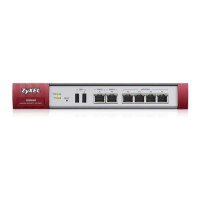Chapter 31 Web Authentication
ZyWALL Series CLI Reference Guide
252
31.2 Web Authentication Commands
This table lists the commands for forcing user authentication. You must use the configure terminal
command to enter the configuration mode before you can use these commands.
Table 128 web-auth Commands
COMMAND DESCRIPTION
[no] web-auth activate
Enables force user authentication that force users to log in to the Zyxel
Device before the Zyxel Device routes traffic for them. The no command
means the user authentication is not required.
web-auth default-rule
authentication {required
| unnecessary} {no log |
log [alert]}
Sets the default authentication policy that the Zyxel Device uses on traffic
that does not match any exceptional service or other authentication policy.
required: Users need to be authenticated. They must manually go to the
Zyxel Device’s login screen. The Zyxel Device will not redirect them to the
login screen.
unnecessary: Users do not need to be authenticated.
no log | log [alert]: Select whether to have the Zyxel Device generate
a log (log), log and alert (log alert) or not (no log) for packets that
match this default policy.
web-auth [no]
exceptional-service
service_name
Sets a service which you want users to be able to access without user
authentication. The
no command removes the specified service from the
exceptional list.
web-auth google-auth
valid-time <1..5>
Sets maximum time, in minutes, that a user has to authenticate using Google
Authenticator before the authentication attempt fails.
The setting only takes effect if Google Authenticator is enabled in the web
authentication policy.
web-auth login setting
Sets the login web page through which the user authenticates his or her
connection before he or she can then connect to the rest of the network or
Internet. See Table 130 on page 255 for the sub-commands.
web-auth method portal
Sets a client to authenticate with the Zyxel Device through the specifically
designated web portal.
web-auth policy <1..1024>
Creates the specified condition for forcing user authentication, if necessary,
and enters sub-command mode. The conditions are checked in sequence,
starting at 1. See Table 130 on page 255 for the sub-commands.
web-auth policy append
Creates a new condition for forcing user authentication at the end of the
current list and enters sub-command mode. See Table 130 on page 255 for
the sub-commands.
web-auth policy insert
<1..1024>
Creates a new condition for forcing user authentication at the specified
location, renumbers the other conditions accordingly, and enters sub-
command mode. See Table 130 on page 255 for the sub-commands.
web-auth policy delete
<1..1024>
Deletes the specified condition.
To modify a condition, you can insert a new condition (N) and then delete
the one (N+1) that you want to modify.
web-auth policy flush
Deletes every condition.
web-auth policy move
<1..1024> to <1..1024>
Moves the specified condition to the specified location and renumbers the
other conditions accordingly.
[no] web-auth redirect-
fqdn host_str
Set the Fully-Qualified Domain Name (FQDN) of the Zyxel Device interface to
which the clients connect.
The no command removes the specified FQDN.
host_str: the fully qualified domain name for the host.

